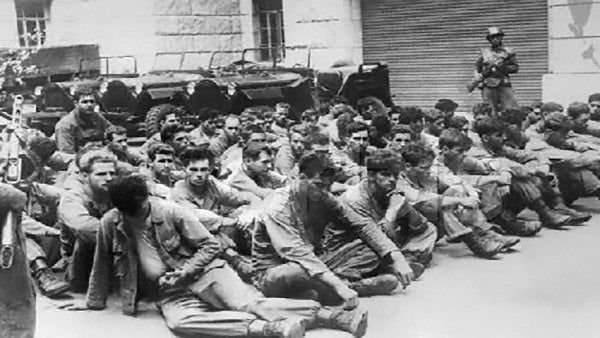PFC Oliver C. Clark, Jr., U.S. Army Part 2: The Tiger Death March and the Apex Camps
Published 1:00 pm Friday, September 15, 2023

- Sovofoto image of Task Force Smith prisoners in Seoul shortly after their capture.
|
Getting your Trinity Audio player ready...
|
By Robert Evers, Covington Veterans Foundation
North Korean Forces captured 81 of the 585 men of Task Force Smith at the July 5, 1950 Battle of Osan. U.S. casualties (killed/wounded/missing) in the first U.S. action of the war stood at 40%. Among the captured was PFC O.C. Clark, Jr. of Straughn. Clark had been in Korea a total of six days.
According to the Andalusia Star-News, O.C. Clark’s parents received word that their son was missing in action about a week later. On July 17, national news outlets reported that the communists had compelled a U.S. prisoner to make a radio broadcast in the captured city Of Seoul, saying he was one of 115 U.S. prisoners of war. His captors also coerced him to say they were being treated humanely. The Red Cross representative in Peking then transmitted these names to the U.S. State Department. O. C. Clark’s name was on the list; this was the only news the Clarks learned about their son during the war.
If the Korean War is known as the “Forgotten War,” the death march of the prisoners in Task Force Smith’s group could be aptly called “The Forgotten Death March.” It constituted some of the worst abuses of captured American servicemen in our nation’s history but is not widely known as the Bataan Death March of WWII.
In the opening days of the Korean War, as the North Korean forces rapidly pushed U.S. and South Korean forces south towards the sea, hundreds of Americans fell into enemy hands. The North Koreans brutally killed hundreds of captured Americans shortly after their surrender. U.N. forces found prisoners with hands bound and shot or bayoneted. The massacres at Hill 303, “Bloody Gulch” and the Sunchon Tunnel in the summer and fall of 1950 horrified the American public.
The North Koreans moved those from Clark’s unit and other U.S. prisoners captured in the war’s first months to Seoul and then to Pyongyang. During this time, they were subjected to beating and interrogations by their captors; some were killed or wounded in air strikes by friendly forces. Given very little food, they were soon malnourished and most quickly developed dysentery and other parasitic diseases. They also relieved little or no medical treatment. Many had to march barefoot for long distances.
With the landings at Inchon in September and the advance of U.N. forces into North Korea, the POWs were moved ever northward toward the Chinese border, away from the advancing U.N. troops.
The prisoners of Task Force Smith were eventually amongst a group of over 800 that included 81 civilian foreign nationals taken prisoner. The youngest civilian was only one, the oldest in her eighties. Some entire families were amongst the group. These civilians were journalists, missionaries, nuns, and foreign businessmen arrested by North Korean forces. The group was eventually moved to Manpo, where they came under the control of a North Korean security police major who became known as “The Tiger’, the moniker given to him by the prisoners because of his ruthless actions. His assignment was to lead the captives to permanent prison camps set up on the border with Red China.
Through an interpreter, the Tiger told the group that they would be making a long march to be conducted in a military fashion. When the senior civilian, British Commissioner Herbert A. Lord of the Salvation Army, pleaded with the Tiger that the group that already contained many seriously ill and wounded could not make such an effort, The response was, “Then let them march till they die. That is a military order.”
The route was to cover 100 miles over the nine days. It set out on October 31, 1950. The Tiger set a grueling pace that quickly exhausted the already weakened captives. Guards constantly prodded the prisoners with rifle butts and bayonets. The small children of the group had to run to keep up with their families. Food was small amounts of corn and weak cabbage stew, if at all.
When the Tiger felt that too many Americans were slowing down, he ordered an Army Lieutenant to come forward, ordered him to kneel, and executed him to set an example to the others. Inevitably, many could go no further and were killed by the North Koreans where they lay. By this time, it was reaching freezing temperatures, and the prisoners were still wearing only their summer fatigues and many without shoes.
When they reached Andong on the snowy Yalu River, nearly 100 of the captives were dead from exhaustion, disease, cold, or execution. Upon their arrival, the prisoners were forced to do calisthenics in the snow.
Hope that their ordeal was over quickly vanished. The group was moved from Andong then to Hanjang-Ni, and then to Chunggang. These camps, situated on the Tumen River at the highest point of North Korea, are known as the Apex Camps. They contained only the Tiger Death March prisoners. They were held at Chunggang-jin from 9 to November 16, 1950, and Hanjang-ni from November 17, 1950, through March 27, 1951. and Andong from March 27 to October 10, 1951.
At the first two camps, the death rate was horrendous. Many of those not directly killed by the long march would soon die from the lingering effects of exhaustion, malnutrition, inhumane treatment, and a lack of medical attention. Food consisted of about a glass full of boiled millet a day.
During the brutal winter of 1950-51, other more permanent camps further south on the Yalu were established to hold U.N. forces; these likewise proved highly deadly for captives.
Almost all U.S. POWs would eventually come under Communist Chinese control. Conditions improved as the communists realized the propaganda and bargaining value of the U.N. prisoners. Most Americans who died in captivity did so in the first few months of the war while under North Korean control.
Nearly half of those 700 soldiers in O.C. Clark’s group who endured the death march and the Apex camps would be dead the following spring. Only 292 would return home alive.
When the cease-fire was finally signed in August 1953, it provided for the release of all prisoners. Families who had not heard from their loved ones hoped they might eventually discover their fate. The released U.S. prisoners were debriefed and asked about the fate of the missing captives. Of the 7,140 U.S. servicemen captured during the war, 40% (2700) died in captivity.
It was then learned that O. C. Clark had died of untreated wounds, exposure, and pneumonia in February of 1951 at the Hanjanj-Ni prison camp and was buried on the outskirts of the camp. One of the survivors, Wayne “Johnnie” Johnson, kept a list of all deaths in the Apex Camps, which proved invaluable to determining the date and cause of death of many prisoners. Risking severe punishment, he was able to keep the list secret and smuggled it out with him upon his repatriation. At first, his U.S. debriefers had little interest in the list. In 1989, he brought the list to a reunion of the Tiger Death March survivors and, eventually, to the attention of the Department of Defense. It contained the names of 496 POWs who died in the prison camp. Now known as “Johnnie’s List,” it gave closure to many surviving family members. In 1996, Johnson was awarded the Silver Star for his bravery in compiling the list.
Over 7,000 US servicemen remain unaccounted for from the Korean War, and most remain in North Korea. O. C. Clark’s body has still not been recovered. Private First Class Clark is memorialized on the Courts of the Missing at the National Memorial Cemetery of the Pacific. A headstone for Clark stands in Good Hope Cemetery in the northern part of Covington County, stating, “Died in North Korean prison camp. Gone but not forgotten.”
Sources:
Carlson, Lewis H. – Remembered Prisoners of a Forgotten War: an Oral History of the Korean War POWs
The Andalusia Star News, July 29, 1950
United States Defense POW/MIA Accounting Agency







